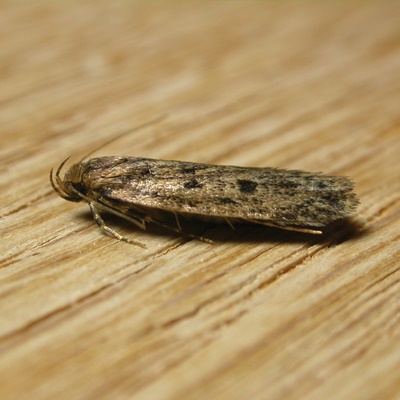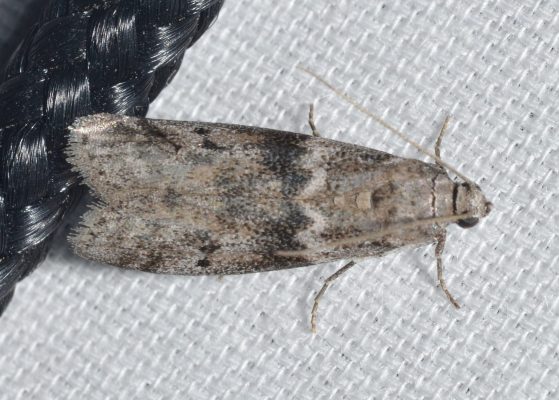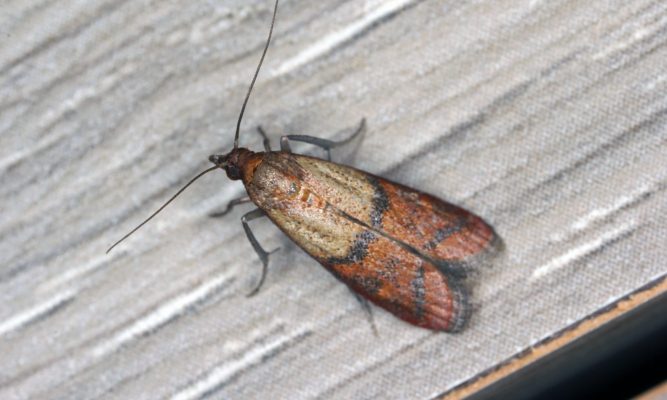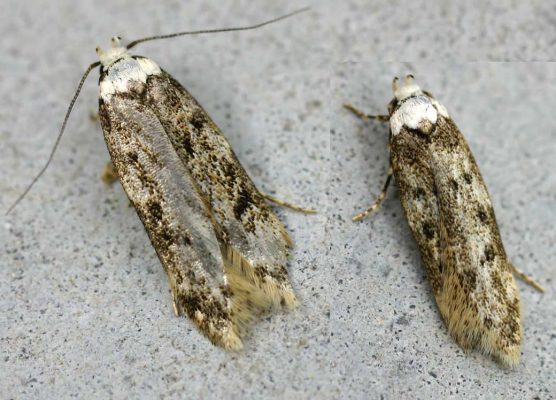Pantry moths are overlooked pests inside kitchens. The reality is that while these pests aren’t dangerous, they can cause significant damage.
Pantry moth infestations are hard to identify and treat. If you have them inside your pantry, you will likely need to throw away everything you have if you want any hope of getting rid of them.
Don’t worry; I’m here to help. In this post, I will go over how to identify pantry moths and get rid of them most effectively.
What are pantry moths?
Pantry moths are a type of moth that feeds on and reproduces inside dry food and other packaged food.
These moths will lay their eggs inside dry food. The moth larva will feed on the food to survive until they are ready to pupate.
After they infest, your food will be damaged with small holes, frass, and cocoon skins from the larvae.
Pupated moths can also live inside stored food but will often fly out of the package, searching for other areas to lay their eggs.
They are commonly found on walls, shelves, and other areas near stored food.
Where Do Pantry Moths Come From?
Pantry moths are typically introduced into homes through newly purchase packaged goods.
Infestations usually begin at grocery stores or food storage warehouses.
The goods you purchase unknowingly contains pantry moth infestations. Once inside your home, these infestations will spread to other content inside your pantry.
They can easily spread to other contents due to adults’ ability to fly and the larvae’ ability to chew through plastic and thin cardboard.
While less likely, it’s also possible that infestations entered from outdoor.
How To Identify Pantry Moths?
There are different species of pantry moths. The similarity is that these moths survive on dry food typically found inside the pantry.
The four most common species of moths are:
- Brown house moth
- Mediterranean Pantry Moth
- Indian Meal Moth
- White-shouldered house moth
Brown House Moth

- Color: Bronze-brown with dark brown or black flecks on the forewings.
- Size: 8 – 14mm
- Activity: Active year-round
- Distribution: Worldwide
Feces are oblong and larger than the common clothes moth.
Cause more damage than the common clothes moth.
Mediterranean Pantry Moth

- Color: brown/grey primary color with a dark zig-zag pattern across their wings
- Size: 6-12mm
- Activity: Active year round
- Distribution: Worldwide
Larva live and feed in silken tubes that they spin using the food they eat.
They have a signature stance that no other house moth does—extending the forelegs, raising the head, giving the body a sloped appearance with the head at the highest point and the abdomen the lowest.
Indian Meal Moth

- Color: outer half of the forewings are bronze or dark grey, while the upper half is yellow-grey with a dark band between.
- Size: 8 – 10mm
- Activity: Active year-round
- Distribution: Worldwide
Commonly feed on grains such as cereals and other products.
Leave food webbed together
Also commonly known as “waxworms”.
Larvae are off-white with brown heads.
White Shouldered House Moth

- Color: white shoulders, thorax, and head, greyish-brown wings with specs of black on their forewings
- Size: 8 – 12 mm
- Activity: Active year round
- Distribution: Worldwide
Although they prefer grains, they are omnivorous and can feed on a variety of different dried food.
Larvae produce silk casings that the hide in
They reproduce all year round, making them hard to get rid of.
They have a higher chance of reproducing and finding these moths if there is high humidity or excess moisture in the surrounding areas.
Pantry Moth Lifecycle
Pantry moths go through 4 different stages in their life.
- Eggs
- Larvae
- Pupa
- Adult
Eggs
First, adult female pantry moths lay their eggs.
Pantry moths will lay their eggs inside dry food or near food sources such as on cardboard boxes or panty liners.
After the eggs are laid they typically hatch in 1 week or less. After the eggs hatch, the larvae will begin eating any food near them.
Larvae
Larvae typically take 2 weeks to 6 weeks to develop before they begin to pupate. The larvae will spin a cocoon where they will spend their time during the pupating phase.
Pupa
During the pupa phase, the pantry moth larva will remain hidden inside the cocoon until they are ready to pupate.
The conditions will dictate how long the larvae remain in the pupa phase. This stage can last between 5 days and 1 month.
Typically higher humidity situations result in a faster pupation phase while hotter and drier conditions result in a longer pupation phase.
How To Get Rid of Moths
1. Empty the pantry and inspect its contents.
The first thing you want to do if you suspect that you have pantry moths is to empty your pantry and inspect the contents.
It’s important that you inspect your entire pantry and not just packages or dry food that currently has pantry moths.
Pantry moths can survive in different areas of your pantry. Eggs, larva, and cocoons can be found inside pantry liners, on boxes, and behind jars and other containers.
You also want to inspect the content of your pantry for any signs of pantry moths.
Any containers that contain signs of pantry moths should be thrown away. You want to insect dry food that is still in packages.
The larva can eat their way through the plastic and thin cardboard boxes. These entry points won’t be noticeable so it’s important that you open all the items in your pantry and inspect them thoroughly.
2. Place all food inside Airtight containers
All dry food should be placed in airtight containers. Airtight containers will keep your food safe from pantry moths of all kinds.
Not only will it keep your food safe it will also keep your food fresh for longer.
You won’t have to worry about a pantry moth because they won’t be able to enter your containers.
To ensure the efficiency of your airtight containers, you must always make your properly close your containers.
If not closed properly, you leave your food susceptible to pantry moths.
3. Dispose of food, not in airtight containers
Any food that is not stored in airtight containers should be disposed of. Food that is not inside airtight containers could be infested with pantry moths.
Certain dry foods such as flour, rice, beans, or other grains are difficult to determine if there are pantry moth inside.
Often the larva, eggs, and cocoons can get buried, making it difficult to detect.
Any food stored in zip lock bags, paper bags, or thin plastic should be disposed of properly.
Only food stored in airtight containers, glass containers, or thick carboads should be kept. Any other food should be disposed of unless you are certain there are no pantry moths inside.
4. Dispose or Clean Shelf Liners
Shelf liners are the primary areas where pantry moths will hide. You can find all the different phases of pantry moths hiding on or under pantry liners.
Pantry liners are key spots that you can find eggs, pupa, and larvae. They are especially susceptible when they are moist or water-damaged.
This makes it ideal for pantry mots to survive.
If you have reusable or washable panty liners, you can wash them with hot water and bleach. I recommend running them on the high heat setting of the dishwasher with bleach.
This will make sure that you kill any eggs, larvae, or adult moths.
If your liners are damaged, I recommend replacing them. Pantry liners are relatively cheap, making it inexpensive to replace all the pantry liners in your home.
5. Clean Thoroughly
You want to make sure that you clean your pantry thoroughly. This includes shelves, airtight containers, and any other containers that can be easily cleaned.
One of the best natural ways to clean your pantry includes a mixture using:
- Hot Water
- Vinegar
- Essential Oil
As an alternative, you can also use a one-to-one ratio of bleach and water.
Be sure to spray all areas thoroughly and wide down all surfaces once you are complete.
I recommend using a spray bottle and a microfiber cloth to make sure that you clean every part of your pantry properly.
6. Don’t use Pesticides
You want to avoid using pesticides in your food preparation areas including your pantry.
Spraying toxic pesticides near your food is dangerous. Especially those with residual effects.
This means that even if you touch the pesticide after it’s application, there will be some chemical residue.
Since your food will be in this area, the risk of ingesting pesticides is too dangerous and should be avoided.
One common pesticide often used mothballs. While mothballs can kill moths, they are highly toxic to both humans and pets.
Using these in confined areas such as pantries or kitchens can be dangerous.
If you plan on using moths ball, remember to follow the ventilation and coverage directions before using mothballs inside your home.
7. Use Moth Traps
Moth traps are one of the most effective options that you can purchase in stores. These traps are ideal because they are in a shape that attracts moths.
Likewise, high-quality traps include moth pheromones that attract moths as well.
Using moth pheromone boards makes boards much more effective.
You can place these around your pantry once you identify the infestation. These will help you eliminate the current population and help you monitor the population after treating your home.
You can place these traps in small gaps, crevices, or other tight, dark areas that pantry months find attractive.
Frequently Asked Questions (FAQ)
Are Pantry Moths Harmful?
No, pantry moths aren’t harmful. They are more of a nuisance. Pantry moths don’t bite, nor do they transmit any diseases.
Even if you accidentally consume infested food, you have nothing to worry about. Although it’s quite disgusting to imagine eating them is not harmful or dangerous.
The main harm that they cause is to your food and pantry. Any food infested with pantry moths needs to be thrown away.
Do Pantry Moths Carry Diseases?
No pantry moths don’t carry any known diseases. Studies show that although they are found worldwide, they don’t carry any diseases, pathogens, or parasites.
Consuming these insects won’t transmit any diseases or pathogens to your body. They are completely harmless to humans. Even if you touch them or destroy them, they pose no health issues.
Do Pantry Moths Bite?
No pantry moths don’t bite humans. While it’s expected that they can bite humans, they are not interested in humans.
Other species of moths are more aggressive and tend to bite more often, but pantry moths do not.
There are no reported cases of pantry moth bites to humans.
Will Pantry Moths Go Away on Their Own?
Pantry moths don’t die off on their own. They are not seasonal pests which means that they reproduce all year long.
This means that they won’t die off on their own. Pantry moth infestations won’t die on their own; it will continue to grow as long as they are a food source for them to survive on.
How Long Do Pantry Moths Survive?
Adult pantry moths have short lifespans. Adult pantry moths typically live between 1-3 weeks.
Larva are the longest-lasting stage of the pantry moth lifecycle. They can survive for as long as one month in this stage.
Can Pantry Moths Fly?
Yes, pantry moths can fly. They have two large forewings that allow them to fly. Most moths can fly, although they are not the strongest flyers.
They typically use their flying ability to travel short distances. Their flight is often erratic and weak.
